
An in-depth review of Slipped Capital Femoral Epiphysis (SCFE).
If you're interested in orthopedics or pediatrics you'll definitely want to check this review out!
1/
If you're interested in orthopedics or pediatrics you'll definitely want to check this review out!
1/

SCFE’s are an adolescent hip pathology with an average age of onset of 11-12.
The diagnosis may be initially missed because the patient may present with thigh or knee pain.
The diagnosis may be initially missed because the patient may present with thigh or knee pain.
Risk factors include:
✯ Obesity
✯ Male gender
✯ Prior radiation
✯ Endocrine abnormalities
✯ Certain ethnicities (e.g. African American)
Obesity is one of the most important and modifiable risk factors.
✯ Obesity
✯ Male gender
✯ Prior radiation
✯ Endocrine abnormalities
✯ Certain ethnicities (e.g. African American)
Obesity is one of the most important and modifiable risk factors.
SCFE occurs when the femoral head displaces in relation to the neck at the physis.
Pathogenesis:
✯ Increased axial loads on a susceptible physis
- Obesity increases axial loading
- Endocrine/renal dx may weaken the physis
Pathogenesis:
✯ Increased axial loads on a susceptible physis
- Obesity increases axial loading
- Endocrine/renal dx may weaken the physis
SCFE should be suspected in an adolescent that presents with atraumatic hip/knee pain or limping.
Pain most commonly occurs in the hip/groin (50%), but may also occur in the thigh or knee.
Patients typically have limited hip IR and may have a + Drehmann Sign.
Pain most commonly occurs in the hip/groin (50%), but may also occur in the thigh or knee.
Patients typically have limited hip IR and may have a + Drehmann Sign.

A line drawn along the superior femoral neck on AP radiograph normally intersects the femoral head (Kleins Line).
In patients with SCFE the line will only partially intersect or not at all with the femoral head. When this occurs what is this sign called?
In patients with SCFE the line will only partially intersect or not at all with the femoral head. When this occurs what is this sign called?
When Kleins line fails to intersect the femoral head this is termed a Trethowan sign.
The S-sign is when a line drawn along the inferior femoral head/neck on a frog-leg lateral is discontinuous or asymmetric.
The S-sign was introduced in a 2018 study by Rebich et al.
The S-sign is when a line drawn along the inferior femoral head/neck on a frog-leg lateral is discontinuous or asymmetric.
The S-sign was introduced in a 2018 study by Rebich et al.

The Southwick Slip Angle Classification system grades the severity of displacement based on the difference between the affected and unaffected hip.
✯ Mild (<30°)
✯ Moderate (30-50°)
✯ Severe (>50°).
7/10
✯ Mild (<30°)
✯ Moderate (30-50°)
✯ Severe (>50°).
7/10

Percutaneous in situ fixation remains the gold standard for treatment
Single fixation is usually sufficient and has a reduced risk of AVN, however unstable SCFE may require a second screw
B/L fixation may be warranted if high risk:
✯ <10 yo
✯ obese males
✯ endocrine dx
Single fixation is usually sufficient and has a reduced risk of AVN, however unstable SCFE may require a second screw
B/L fixation may be warranted if high risk:
✯ <10 yo
✯ obese males
✯ endocrine dx

Complications may include:
✯ Contralateral slippage
✯ AVN of the femoral head
✯ Chronic pain
✯ Limb length discrepancy
Patients whose weight is <50th percentile presenting with SCFE may require an endocrine workup.
✯ Contralateral slippage
✯ AVN of the femoral head
✯ Chronic pain
✯ Limb length discrepancy
Patients whose weight is <50th percentile presenting with SCFE may require an endocrine workup.
Conclusion: Early diagnosis of SCFE is essential for timely treatment to have a chance to optimize long-term hip function.
SCFE's variable presentation requires physicians to be vigilant to catch it early.
SCFE's variable presentation requires physicians to be vigilant to catch it early.
If you enjoyed this review, please like or retweet to help the page grow and give us a follow!
Author: @CSMorford
#SCFE #Hip #Pediatrics #Radiology #Orthopedics #OrthoTwitter #Ortho #Bones #Fracture #Trauma #Tweetorials #MedED #MedicalEducation #MedTwitter #MedStudent
Author: @CSMorford
#SCFE #Hip #Pediatrics #Radiology #Orthopedics #OrthoTwitter #Ortho #Bones #Fracture #Trauma #Tweetorials #MedED #MedicalEducation #MedTwitter #MedStudent
• • •
Missing some Tweet in this thread? You can try to
force a refresh











